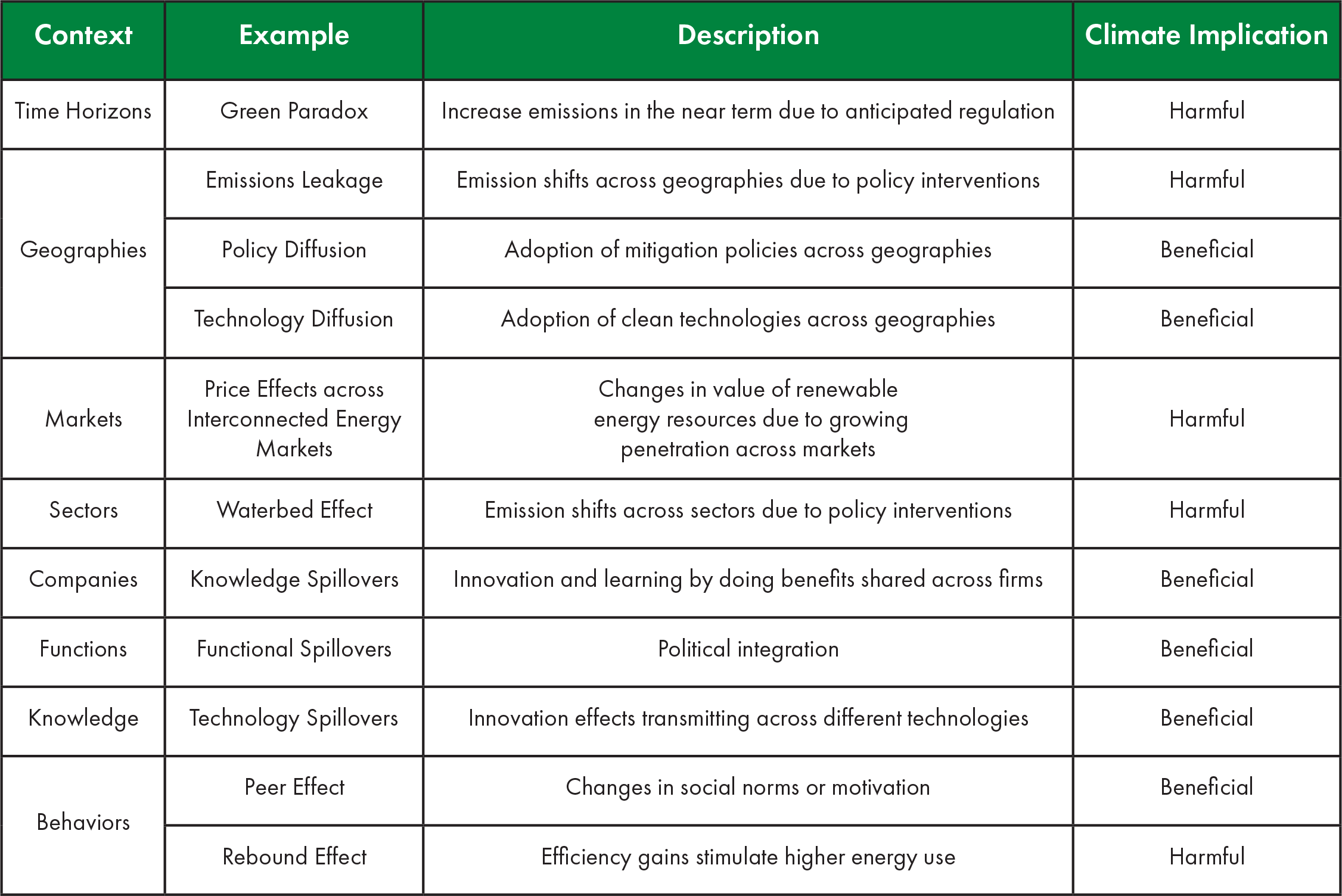
Good Spillover, Bad Spillover? Industrial Policy, Trade, and the Political ...
Empirical research suggests that spillover effects frequently exceed the intended impacts of policy decisions. Knowledge and technology spillovers of early policies to promote renewable energy, for instance, precipitated the rapid cost decline and worldwide diffusion of solar photovoltaic energy, which has been identified by the Intergovernmental Panel on Climate Change as the largest near-term contribution to greenhouse gas emission reductions. Just as spillover effects have enabled past successes in climate change mitigation, however, they also threaten to undermine accelerating decarbonization efforts. While contested in its magnitude, emissions leakage—when emissions associated with production, consumption or investment patterns are displaced as a result of climate policies—could stall or reverse progress with decarbonization if emissions merely relocate rather than undergo an aggregate decline.
Because they are difficult to define and quantify, spillover effects have been neglected in the theoretical framing of climate policy instrument choice. Research on them remains fragmented, with no unifying definitions or methodological framework. Some spillover effects have been extensively studied, while others remain opaque, with scarcely understood causal mechanisms and interactions. That may now change, as influential actors and initiatives, such as the Inclusive Forum on Carbon Mitigation Approaches, the G7 Climate Club, and a task force of international organizations led by the World Trade Organization,1 have recently begun to feature spillover effects in their work. While a promising development, the initial outputs of these efforts reflect the lack of an overarching conceptual paradigm and reveal a disciplinary bias in the spillover effects selected for further exploration.
In common usage, the term ‘spillover’ refers to situations in which activities in one context generate effects in another context. Past research shows that spillover effects can be positive or negative, intended or unintended, and manifest themselves across a variety of dimensions: time horizons, geographies, markets, sectors, companies, technologies, functions, and behaviors. They share many features with the economic concept of externalities, but have also been studied in non-market settings. Geographic spillover effects mediated through international trade have received the greatest attention in the policy debate, and also feature in a growing number of policies aimed at mitigating transboundary spillover harm.

Table 1: Types of climate-related spillover effects described in the literature, across contexts and with observed climate implications.
Spillover effects also have implications for the political economy of climate action. Spillover effects beneficial to climate action tend to correlate with policy interventions that socialize the cost of decarbonization, such as subsidies for the development and deployment of emission reduction technologies. Harmful spillover effects, by contrast, tend to accompany policy interventions that impose a private cost on emissions, such as carbon pricing. Research has consistently affirmed that this latter category of policy interventions faces greater political economy constraints, because it incurs immediate and concentrated costs while only yielding diffuse, long term benefits. A strategy emerging from this observation, the idea of ‘policy sequencing’, acquires new relevance in the presence of spillover effects, creating opportunities for staged interventions that initiate a virtuous policy cycle to build supportive constituencies and increase climate policy ambition.
Recent policy trajectories in the United States and the European Union present a case study for the rise of industrial policy and its ramifications for the spillover effects of climate action. Responding to the economic shocks of a global pandemic and escalating military conflicts in different regions of the world, as well as distributional consequences arising from decades of expanding trade liberalization, both sides of the Atlantic are increasingly resorting to market interventions to accelerate decarbonization while advancing economic, social and political priorities. Spillover effects— such as supply chain disruptions, surging energy costs, and erosion of the domestic industrial base—have prompted many of these industrial policies, which will in turn result in new and unanticipated spillover effects.
A shared feature of the current generation of industrial policies is their reliance on provisions that limit or condition access to markets and incentives, such as border carbon adjustments and product carbon requirements, anti-dumping tariffs, countervailing duties, local content requirements, and export controls. Not only are these measures regularly opposed by trade partners, threatening to destabilize international climate cooperation, but they also erect barriers to the international flow of goods, services, capital, and knowledge which enabled past spillover benefits. While the concerns these policies seek to address are valid, their implications—including spillover effects—need to be carefully understood. Unconsidered use of trade-related climate measures risks increasing the cost and time horizon of decarbonization, while also inciting diplomatic tensions. Long-term implications for innovation spillovers and learning rate effects, in particular, need to be better understood.
Strategic cooperation is needed to manage spillover effects for enhanced climate action. Cooperation can help leverage positive and limit negative spillovers while promoting a virtuous sequence of technology and policy diffusion. First, spillover effects need to be better understood in order to inform planning and policy decisions, using common metrics and improved tools to reflect them in economic modeling and regulatory impact assessments. Second, cooperation can help identify principles and best practices for domestic policy design to actively promote spillover benefits and limit spillover harm. Third, countries should expand existing partnerships on technological innovation and climate finance, deploying new collaborative mechanisms that align incentives for the diffusion of climate policies and emission reduction technologies. Strategic cooperation can help trade fulfill its potential as an enabler of—rather than threat to—enhanced climate action.
Footnotes:
- World Trade Organization, Organization for Economic Co-operation and Development, International Monetary Fund, United Nations and World Bank, ‘Working Together for Better Climate Action: Carbon Pricing, Policy Spillovers, and Global Climate Goals’ (Geneva: WTO, 23 October 2024), https://www.wto.org/english/res_e/booksp_e/climate_action_e.pdf.
Distribution channels: Environment
Legal Disclaimer:
EIN Presswire provides this news content "as is" without warranty of any kind. We do not accept any responsibility or liability for the accuracy, content, images, videos, licenses, completeness, legality, or reliability of the information contained in this article. If you have any complaints or copyright issues related to this article, kindly contact the author above.
Submit your press release